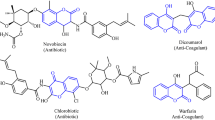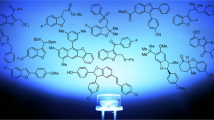Abstract
This review deals with the frequency of occurrence of literature references to various types of reagents used in syntheses of the pyridine ring and a number of its heterocyclic analogs (classed as heteroalternant systems). It is shown that the nature of the terminal groups in the reagents, the parity of the chain of atoms between the terminal groups, and the position of the heteroatom are interrelated and are subject to “magic” rules (principles of alternation and heteroalternation). These rules can be interpreted within the frame of a new concept, “structure—synthesis,” based on preservation of the electrophilic-nucleophilic nature of the reagents in the heterolytic formation of even-membered rings. A complete classification of pyridine-ring syntheses that are allowed by the rules provides a means for predicting the polar type of reagents for the last unknown synthesis of pyridines of the type CNCCC+C.
Similar content being viewed by others
References
E. V. Babaev and N. S. Zefirov, Khim. Geterotsikl. Soedin., No. 6, 808 (1992).
G. R. Newkome and W. W. Paudler, Contemporary Heterocyciic Chemistry: Synthesis, Reactions and Applications, Wiley, New York (1982).
S. S. Nametkin, Heterocyclic Compounds [in Russian], Nauka, Moscow (1981).
R. M. Acheson, An Introduction to the Chemistry of Heterocyclic Compounds, Wiley, New York (1977).
J. A. Joule and G. F. Smith, Heterocyclic Chemistry, Van Nostrand, New York (1972).
A. Albert, Heterocyclic Chemistry: An Introduction, Athlone, London (1968).
A. R. Katritzky and J. M. Lagowski, Heterocyclic Chemistry, Wiley, New York (1960).
L. A. Paquette, Principles of Modern Heterocyclic Chemistry, Benjamin-Cummings, New York (1968).
A. R. Katritzky and C. W. Rees (eds.), Comprehensive Heterocyclic Chemistry, Vols. 1–8, Pergamon Press, Oxford (1984), 1–8.
D. Barton and W. D. Ollis (eds.), Comprehensive Organic Chemistry, Vol. 4, Heterocyclic Compounds, Pergamon Press, Oxford (1979).
R. C. Elderfield (ed.), Heterocyclic Compounds, Vols. 1–7, Wiley, New York (1950).
E. Rodd (ed.), Chemistry of Carbon Compounds, Vol. 4, Elsevier, Amsterdam (1957).
R. Anshutz (ed.), Richter-Anschutz Chemie der Kohlenstoffverbindungen, Vol. 3, Acad. Verlag Ges., Leipzig (1931).
R. P. Kreher (ed.), Houben-Weil Methoden der Organischen Chemie, Vol. E 7a (Hetarene II), Thieme Verlag, Stuttgart, New York (1991), No. 1.
E. V. Babaev and N. S. Zefirov, Bull. Soc. Chim. Belg., 101, 67 (1992).
E. V. Babaev, D. E. Lushnikov and N. S. Zefirov, J. Am. Chem. Soc., 115, 2416 (1993).
P. Barone and M. Chanon, in: Computer Aids to Chemistry, G. Vernin and M. Chanon (eds.) Halstead Press, New York (1986).
G. Jones, in: Quinolines, G. Jones (ed.) Part 1, Wiley, New York (1977), p. 93.
K. T. Potts, in: Comprehensive Heterocyclic Chemistry, A. R. Katritzky and C. W. Rees (eds.) Vol. 5, Pergamon Press, Oxford (1984), p. 111.
A. McKillop and A. J. Boulton, in: Comprehensive Heterocyclic Chemistry, A. R. Katritzky and C. W. Rees (eds.) Vol. 2, Pergamon Press, Oxford (1984), p. 67.
A. R. Katritzky, Handbook of Heterocyclic Chemistry (Comprehensive Heterocyclic Chemistry, Vol. 9), Pergamon Press, Oxford (1985), p. 382.
M. G. Bures and W. L. Jorgensen, J. Org. Chem., 53, 2504 (1988).
E. V. Babaev, Bull. Soc. Chim. Belg., 101, 823 (1992).
S. I. Bobrovskii, E. V. Babaev, and Yu. G. Bundel', Khim. Geterotsikl. Soedin., No. 2, 203 (1987).
G. Jones, in: Comprehensive Heterocyclic Chemistry, A. R. Katritzky and C. W. Rees (eds.) Vol. 2, Pergamon Press, Oxford (1984), p. 395.
D. M. Smith, in: Comprehensive Organic Chemistry, D. Barton and W. D. Ollis (eds.) Vol. 4, Heterocyclic Compounds, Pergamon Press, Oxford (1979), p. 3.
H. S. Mosher, in: Heterocyclic Compounds, R. C. Elderfield (ed.) Vol. 1, Wiley, New York (1950).
N. Campbell, in: Chemistry of Carbon Compounds, E. Rodd (ed.) Vol. 4A, Elsevier, Amsterdam (1957), p. 488.
H. Maier-Bode and J. Altpeter, Das Pyridine und seine Derivate in Wissenschaft und Technik, W. Knapp Verlag, Halle (1934).
Yu. I. Chumakov, Pyridine Bases [in Russian], Kiev, Tekhnika (1965).
K. Schofield, Heteroaromatic Nitrogen Compounds: Pyrroles and Pyridines, Butterworths, London (1967).
F. Brody and R. Ruby, in: Pyridine and Its Derivatives, Part 1, E. Klingsberg (ed.) Interscience, New York (1960), p. 99.
N. S. Boodman, J. O. Hawthorne, P. X. Maskiantonio, and A. W. Simon, Pyridine and Its Derivatives, Supplement, Part 1, R. Abramovich (ed.) Interscience, New York (1974), p. 185.
G. R. Newkome (ed.), Pyridine and Its Derivatives, Supplement, Part 5, Interscience, New York (1984).
M. A. Yurovskaya and A. Z. Afanas'ev, Khim. Geterosikl. Soedin., No. 7, 867 (1991).
V. L. Rusinov and O. N. Chupakhin, Nitroazines [in Russian], Nauka (Siberian Branch), Novosibirsk (1991).
E. V. Babaev and S. I. Tsitovskii, Vestn. Mosk. Gos. Univ., Ser. 2, Khim., in press.
F. Krohnke, Angew. Chem., 65, 605 (1953).
J. Thesing and A. Muller, Chem. Ber., 90, 711 (1957).
R. Gompper and R. Sobota, Angew. Chem., 90, 808 (1978).
U.S. Pat. 2,680,743, P. G. Stevens to General Aniline and Film Corp., Chem. Abstr., 49, 6315 (1955).
A. Garming, D. Kern, G. Cohausz, G. Hillert, P. Gelbke, and D. Severin, Liebigs Ann. Chem., 1822 (1977).
A. Streitwieser, Molecular Orbital Theory for Organic Chemists, Wiley, New York (1961).
J. E. Baldwin, J. Chem. Soc., Chem. Commun., 734 (1976).
J. D. Baty, G. Jones, and C. Moore, J. Chem. Soc. C, 2645 (1967).
E. A. Prill and C. M. McElvain, J. Am. Chem. Soc., 55, 1233 (1933).
A. Cohen, J. W. Haworth, and E. G. Hughes, J. Chem. Soc., 4, 4374 (1952).
M. I. Farberov, V. V. Antonova, B. F. Ustavshchikov, and N. A. Titova, Khim. Geterotsikl. Soedin., No. 12, 1587 (1975).
K. V. Vatsuro and G. A. Mishchenko, Name Reactions in Organic Chemistry [in Russian], Khimiya, Moscow (1976).
A. R. Surrey, Name Reactions in Organic Chemistry, Academic Press, New York (1954).
H. Feuer, G. B. Bachman, and W. May, J. Am. Chem. Soc., 76, 5124 (1954).
F. Feist, Ber., 35, 1545 (1902).
K. D. Gunderman and H. U. Alles, Chem. Ber., 102, 3014 (1969).
P. Molina, C. Conesa, and M. D. Velasko, Tetrahedron Lett., 34, 175 (1993).
P. Molina, M. J. Vilaplana, and A. Pastor, Synlett., 11, 873 (1992).
P. Molina, A. Lorenzo, and E. Aller, Tetrahedron, 48, 4601 (1992).
T. J. Kametani, K. Fukumoto, in: Isoquinolines, G. Grethe (ed.), Part 1, Wiley, New York (1981), p. 139.
R. I. Fryer, J. V. Early, and W. Zally, J. Heterocycl. Chem., 4, 149 (1967).
R. R. Bard and M. G. Strauss, J. Org. Chem., 42, 435 (1977).
W. Borsche and A. Herbert, Liebigs Ann. Chem., 546, 293 (1941).
H. E. Baumgarten and M. R. DeBrunner, J. Am. Chem. Soc., 76, 3489 (1954).
Author information
Authors and Affiliations
Additional information
This article is dedicated to Prof. A. R. Katritsky on the occasion of his 65th birthday.
See [1] for Communication 1.
Translated from Khimiya Geterotsiklicheskikh Soedinenii, No. 7, 937–961, July, 1993.
Rights and permissions
About this article
Cite this article
Babaev, E.V. Molecular design of heterocycles. 2. “Structure-synthesis” magic rule in the synthesis of six-membered heteroaromatic rings (review). Chem Heterocycl Compd 29, 796–817 (1993). https://doi.org/10.1007/BF00528890
Received:
Issue Date:
DOI: https://doi.org/10.1007/BF00528890




